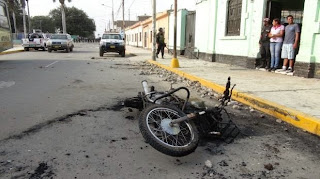Once, long ago it was probably the center of
commercial and social activity in an important village at that time known as Tùcume.
We don’t know when the church was built,
but we can make an educated guess. The oldest known Catholic Church in Peru was
built in 1534 in Piura; just two years after Pizarro founded the city. In Lima, founded in 1535 again by Pizarro,
churches started taking shape in 1536. In 1536 Juan Roldàn Dàvila (born 1490 in
Spain) was entrusted by Pizarro with the administrative control of Tùcume and
the surrounding area. Given the pattern of two years between Spanish founding
and building it is reasonable to assume that the Tùcume church was constructed around
1538 - 1540. Juan probably did not live to see his church completed…he died in
Trujillo in 1538.
Northern coastal Peru lacks the metal mines
that drove the Spanish appetite for wealth, but the fertile valleys irrigated
with water from the mountains provided a wide variety of marine and
agricultural food, as well as cotton and ceramics. Tùcume would have been the center of food processing,
manufacturing, trade and social activities with much of it taking place in the
large open area in front of the church; today the site of the village park.
The church was built by Moche Culture
descendants of adobe brick and other material. Its massive four-foot think walls, high ceiling
and huge archways could have elicited a feeling of awe upon entering. It still has
that same affect if you open up to it. Stand in the archway; touch the walls;
use your imagination and the church will talk to you… it will tell you what it
has seen over the last 475 years. Of all of its memories, both good and bad one
of the most impactful occurred in the year 1622. That’s the year the Milk River
(La Leche Rio) driven by an El Niño overflowed its banks and completely flooded
the village. There had been other floods, but not like this. With that flood
the residents had had enough. The village was relocated 10 miles to the west on
higher ground. What remained was a renamed village - Tùcume Viejo (Old Tùcume),
a handful of villagers and a once proud 400 year old church.
 This is what the church exterior looked
like on August 22, 2014. There still remains enough of it to imagine how it
might have looked all those years ago.
This is what the church exterior looked
like on August 22, 2014. There still remains enough of it to imagine how it
might have looked all those years ago.
The interior is silent and peaceful. The
only indication of human activity is a handful of graves containing the remains
of children placed there by parents who either could not afford a cemetery
funeral, or perhaps felt that the church ground was the more appropriate
location. The graves have been there for many years and have not been
disturbed.
This is how the church exterior appears
today. El Niño and floods are once again threatening the village and church. The
government has committed about $87,000 USD to protect and to some extant
restore the site.
 Walls are being reinforced and new brick is
being added to fill the gaps. It appears at least at this point that the
children’s graves sites are being worked around.
Walls are being reinforced and new brick is
being added to fill the gaps. It appears at least at this point that the
children’s graves sites are being worked around. 




